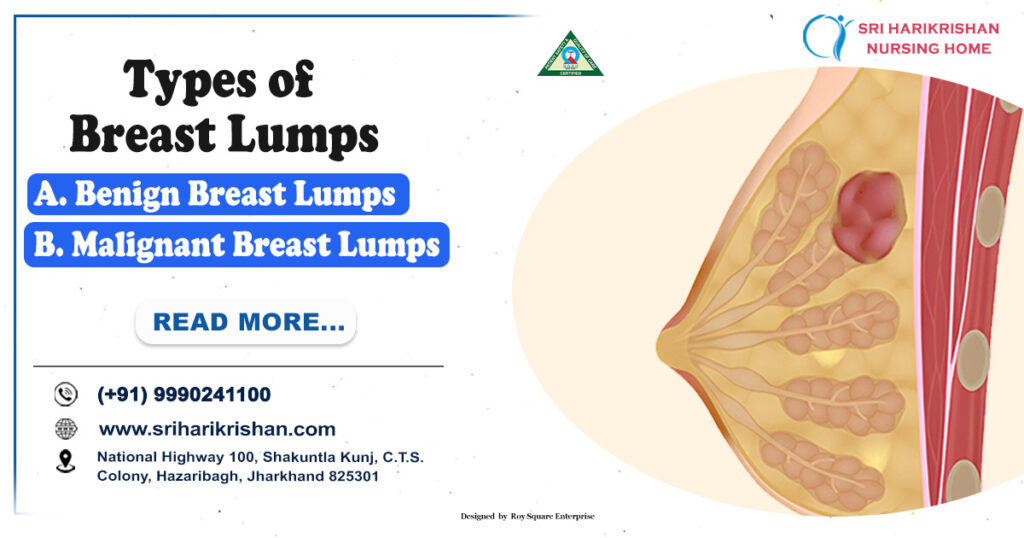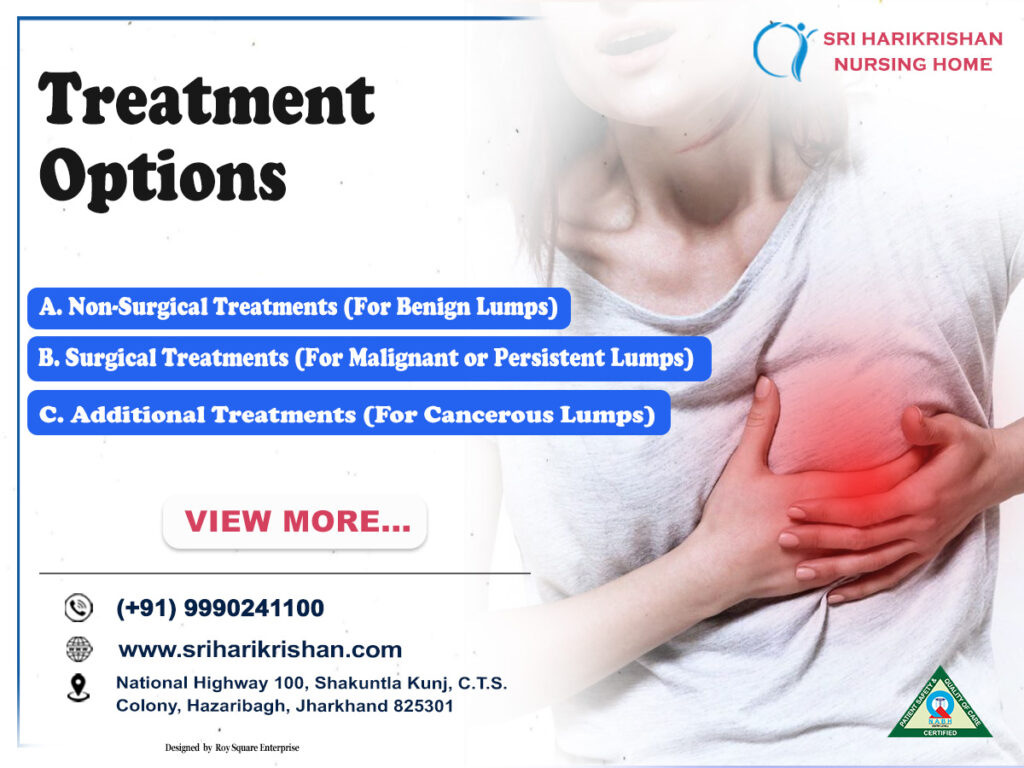Introduction
Finding a breast lump can be alarming for any woman. While not all lumps are cancerous, it’s essential to identify the cause early and get the right treatment. Early diagnosis often leads to better outcomes and peace of mind.
In this detailed guide, we’ll discuss everything about breast lump diagnosis and treatment options—from symptoms, types, and causes to recovery and prevention. Expert insights are also included from Dr. Satveer Singh, Consultant Surgical Oncologist (Breast), Laparoscopic & Endoscopic Surgeon, and Back Pain Specialist, known as the best general surgeon in Hazaribagh, Jharkhand, practicing at Shri Harikrishan Nursing Home.

1. What is a Breast Lump?
A breast lump is a localized swelling, bump, or mass in the breast tissue that feels different from the surrounding area. These lumps can be:
- Soft or hard
- Movable or fixed
- Painful or painless
Not all breast lumps indicate cancer. Many are benign (non-cancerous) and caused by hormonal changes, infections, or cysts. However, any lump should be evaluated by a qualified doctor to rule out malignancy.
2. Symptoms of a Breast Lump
Common symptoms that may accompany a breast lump include:
- A palpable lump in the breast or underarm area
- Breast pain or tenderness
- Nipple discharge (clear, yellow, or bloody)
- Changes in breast size or shape
- Redness, swelling, or skin dimpling
- Inverted nipple or changes in nipple position
If you notice any of these signs, consult Dr. Satveer Singh at Shri Harikrishan Nursing Home, Hazaribagh, for prompt evaluation.

3. Types of Breast Lumps
Breast lumps can be categorized as benign (non-cancerous) or malignant (cancerous):
A. Benign Breast Lumps
- Fibroadenoma: A common non-cancerous tumor found in young women, often smooth and rubbery.
- Breast Cyst: Fluid-filled sacs that can cause tenderness.
- Fibrocystic Changes: Lumpy or rope-like textures due to hormonal fluctuations.
- Leoma: Soft, movable fatty lumps.
- Mastitis or Abscess: Infection-related lumps, often painful and warm to touch.
B. Malignant Breast Lumps
These are cancerous growths that need immediate medical attention. They tend to be hard, irregular, and painless.
Early detection is crucial for successful treatment, and Dr. Satveer Singh, the best general surgeon in Hazaribagh, specializes in accurate diagnosis and management of both benign and malignant breast lumps.
4. Causes of Breast Lumps
Breast lumps can occur due to several reasons, including:
- Hormonal changes during menstruation or menopause.
- Infections like mastitis.
- Injury or trauma to breast tissue.
- Fibroadenomas or cysts.
- Breast cancer (in malignant cases).
- Use of certain medications or hormone therapy.
5. Risk Factors
Certain factors increase the likelihood of developing breast lumps, especially cancerous ones:
- Age (above 40 years)
- Family history of breast cancer
- Early menstruation or late menopause
- Hormone replacement therapy
- Obesity
- Alcohol consumption and smoking
- Sedentary lifestyle
Understanding these risk factors helps in early prevention and regular screening.
6. Diagnosis of Breast Lump
Accurate diagnosis is key to determining the right treatment. At Shri Harikrishan Nursing Home, Dr. Satveer Singh uses advanced diagnostic tools for thorough evaluation:
- Clinical Breast Examination (CBE): Physical inspection and palpation of the breast and underarm area.
- Ultrasound: Helps differentiate between solid lumps and fluid-filled cysts.
- Mammography: X-ray imaging for detecting abnormal growths.
- Fine Needle Aspiration Cytology (FNAC): Extracts fluid or tissue for lab analysis.
- Biopsy: Confirms whether the lump is benign or cancerous.
- MRI Scan: Used in complex or uncertain cases for detailed imaging.
Early and accurate diagnosis by Dr. Satveer Singh ensures personalized and effective treatment planning.

7. Treatment Options
Treatment depends on the type, size, and nature of the lump:
A. Non-Surgical Treatments (For Benign Lumps)
- Observation: Some small, harmless lumps may not need treatment but should be monitored.
- Medication: Antibiotics for infections, or hormonal therapy for fibrocystic changes.
- Aspiration: Removing cyst fluid using a fine needle.
B. Surgical Treatments (For Malignant or Persistent Lumps)
- Lumpectomy: Removing only the lump while preserving the rest of the breast.
- Mastectomy: Removal of the entire breast in advanced cancer cases.
- Lymph Node Dissection: If cancer has spread to nearby lymph nodes.
- Reconstructive Surgery: Restoring the breast’s appearance post-surgery.
C. Additional Treatments (For Cancerous Lumps)
- Chemotherapy
- Radiation Therapy
- Hormone Therapy
- Targeted Therapy
Dr. Satveer Singh, with his expertise in Laparoscopic and Oncologic Surgery, offers advanced, minimally invasive procedures ensuring faster healing, less pain, and improved cosmetic outcomes.
8. Recovery
Recovery depends on the treatment type and the individual’s overall health:
- After minor procedures (like aspiration): Recovery takes 1–2 days.
- After lumpectomy or mastectomy: Patients may need 2–4 weeks for complete recovery.
- Post-cancer treatment: Regular follow-ups and lifestyle adjustments are essential.
Following your surgeon’s advice, maintaining a healthy diet, and performing light exercises promote quicker healing.
9. Complications
If left untreated or improperly managed, breast lumps can lead to:
- Infection or abscess formation
- Breast deformity or scarring
- Spread of cancer (metastasis)
- Emotional distress and anxiety
Timely consultation with Dr. Satveer Singh, the best general surgeon in Hazaribagh, can prevent such complications and ensure comprehensive care.
10. Top 10 Frequently Asked Questions (FAQs)
1. Are all breast lumps cancerous?
No, most breast lumps are benign and non-cancerous, but every lump should be checked by a doctor.
2. How can I tell if a lump is cancerous?
Only diagnostic tests like a mammogram or biopsy can confirm it—avoid self-diagnosis.
3. What should I do if I find a lump in my breast?
Schedule an appointment with a breast specialist like Dr. Satveer Singh for evaluation.
4. Is breast lump surgery painful?
Modern surgical techniques, including laparoscopic procedures, ensure minimal discomfort and faster healing.
5. Can men develop breast lumps too?
Yes, although rare, men can also develop breast lumps or breast cancer.
6. Do all lumps require surgery?
No, some benign lumps can be treated with medications or observation.
7. Can lifestyle changes prevent breast lumps?
Yes. Maintaining a healthy diet, regular exercise, and avoiding alcohol and smoking can help.
8. How often should I get screened?
Women over 40 should get annual mammograms; earlier if there’s a family history of breast cancer.
9. Is early detection really important?
Yes, early detection significantly improves the success rate of treatment.
10. Who is the best doctor for breast lump treatment in Hazaribagh?
Dr. Satveer Singh, Consultant Surgical Oncologist (Breast), Laparoscopic & Endoscopic Surgeon, is widely regarded as the best general surgeon in Hazaribagh, Jharkhand, offering expert breast care and advanced treatment.
11. Why Choose Shri Harikrishan Nursing Home, Hazaribagh?
- Expert Surgeon: Led by Dr. Satveer Singh, a trusted name in surgical oncology and laparoscopy.
- Advanced Diagnostics: Equipped with state-of-the-art imaging and biopsy facilities.
- Comprehensive Breast Care: From diagnosis to surgery and follow-up.
- Personalized Treatment Plans: Based on the patient’s unique needs.
- Comfort and Compassion: Focused on patient safety, comfort, and emotional support.
At Shri Harikrishan Nursing Home, women receive world-class care in a warm, supportive environment.
12. Conclusion
A breast lump should never be ignored, no matter how small or painless it may seem. Early diagnosis and timely treatment can make a life-changing difference.
With the expertise of Dr. Satveer Singh, Consultant Surgical Oncologist (Breast), Laparoscopic & Endoscopic Surgeon, and Back Pain Specialist, at Shri Harikrishan Nursing Home, Hazaribagh, patients can access advanced diagnostic tools and cutting-edge treatments under one roof.
Whether it’s a benign lump or a more serious condition, early consultation ensures faster recovery and better outcomes. Your breast health matters—don’t delay, get checked today.
